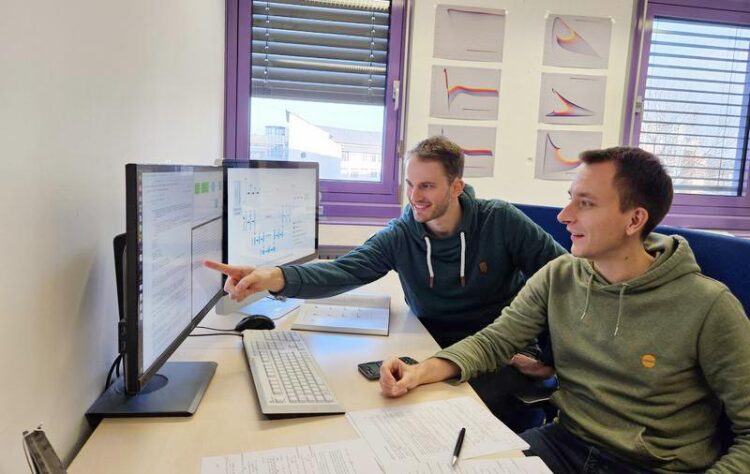Artificial intelligence in astrophysics

Dr. Sebastian Wolfschmidt (in the back) and Christopher Staub
(c) Lisa Krügel / UBT
Bayreuth scientists are investigating the structure and long-term behaviour of galaxies using mathematical models based on Einstein’s theory of relativity. Their innovative approach uses a deep neural network to quickly predict the stability of galaxy models. This artificial intelligence-based method enables efficient verification or falsification of astrophysical hypotheses in seconds.
The research objective of Dr Sebastian Wolfschmidt and Christopher Straub is to investigate the structure and long-term behaviour of galaxies. “Since these cannot be fully analysed by astronomical observations, we use mathematical models of galaxies,” explains Christopher Straub, a doctoral student at the Chair of Mathematics VI at the University of Bayreuth. “In order to take into account that most galaxies contain a black hole at their centre, our models are based on Albert Einstein’s general theory of relativity, which describes gravity as the curvature of four-dimensional spacetime.”
Mathematicians and astrophysicists have been researching the properties of such galaxy models for decades, but many open questions remain. To help answer these questions, Straub and Wolfschmidt have implemented a deep neural network, which represents a completely new approach in this field of research. Neural networks are powerful computational models whose structure is inspired by that of the human brain. They are used in the field of artificial intelligence to detect complex structures in large amounts of data. “The neural network can predict which models of galaxies can exist in reality and which cannot,” says Dr Sebastian Wolfschmidt, research associate at the Chair of Mathematics VI. “The neural network delivers a significantly faster prediction than the numerical simulations used in the past. This means that astrophysical hypotheses that have been put forward over the past decades can be verified or falsified within a few seconds.”
Wolfschmidt and Straub have now presented their findings in the journal “Classical and Quantum Gravity”. “We have been working on these issues at the Chair of Mathematics VI in Prof Dr Gerhard Rein’s research group since 2019. After various analytical and numerical investigations, we realised about a year ago that the use of machine learning can be particularly helpful for some of our problems. Since then, we have developed the deep neural network described above and already have plans for further applications of similar methods,” says Straub.
The calculations of the Bayreuth mathematicians were carried out by the supercomputer of the “Keylab HPC” at the University of Bayreuth and the project emerged from a collaboration with the Chair of Applied Computer Science II – Parallel and Distributed Systems.
Wissenschaftliche Ansprechpartner:
Christopher Straub
Doktorand am Lehrstuhl für Mathematik VI
Mail: christopher.straub@uni-bayreuth.de
Phone: +49 (0)921 55-3284
Originalpublikation:
Straub, C., Wolfschmidt, S., Predicting the stability of star clusters in general relativity, Classical and Quantum Gravity (2024). https://doi.org/10.1088/1361-6382/ad228a
Media Contact
All latest news from the category: Physics and Astronomy
This area deals with the fundamental laws and building blocks of nature and how they interact, the properties and the behavior of matter, and research into space and time and their structures.
innovations-report provides in-depth reports and articles on subjects such as astrophysics, laser technologies, nuclear, quantum, particle and solid-state physics, nanotechnologies, planetary research and findings (Mars, Venus) and developments related to the Hubble Telescope.
Newest articles
Faster, more energy-efficient way to manufacture an industrially important chemical
Zirconium combined with silicon nitride enhances the conversion of propane — present in natural gas — needed to create in-demand plastic, polypropylene. Polypropylene is a common type of plastic found…

Energy planning in Ghana as a role model for the world
Improving the resilience of energy systems in the Global South. What criteria should we use to better plan for resilient energy systems? How do socio-economic, technical and climate change related…

Artificial blood vessels could improve heart bypass outcomes
Artificial blood vessels could improve heart bypass outcomes. 3D-printed blood vessels, which closely mimic the properties of human veins, could transform the treatment of cardiovascular diseases. Strong, flexible, gel-like tubes…





















